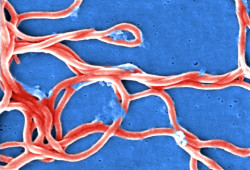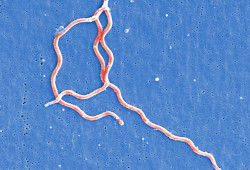Cave Fever
Lyme Disease - Lyme Borreliosis


This disease is known as Lyme Disease in many English speaking countries, the international name is Borreliosis Cave Fever is the name under which this disease is known in Israel. The tick-borne relapsing fever is caused by Borrelia bacteria. It is found in Middle Eastern and Central Asian countries, in the Western U.S.A., South America, Africa, and Central Europe. The infection is the result of the bite of a tick.
This is definitely not a cave disease, in central Europe it is very common and ticks are not found in caves under humid climate conditions. The connection to caves is actually the climate. As those ticks like dark and humid conditions, they are found in caves and abandoned buildings in all arid countries. And the caves are often used as stable for animals like sheep and goats in this climate. As a results, ticks which fed on these animals drop off and hide in the cave. Speleologists are nevertheless prone to Lyme, because they have to go through rough terrain and undergrowth when approaching caves, and the danger of a tick bite is high.
Symptoms start with fever, chills, headaches, sore joints and stomach pain. After improving, patients often suffer a series of relapses. Unfortnately there is no cure, patients usually receive a cocktail of various drugs and vaccines, because none of them is completely effective.
But actually there is a simple trick to avoid those problems: use insect repellants, which also work for ticks. Yes, we know, ticks are spiders, no insects, but who cares if it works? Appropriate clothes, long trousers, are also helpful.
Any trip in tick infested areas should end under the shower checking the whole body for ticks. It often takes hours until they find the right place to bite, so it is possible to get rid of them before they bite. If you find a tick remove them careful with a pincer, avoid the common household remedies like oil, cigarettes, alcohol, and so forth. If the tick gets suffocated or poisoned, it will release the blood it sucked together with alls pathogens into your body. The trick is to grasp the head at the skin with a pincer and pull carefully. Afterwards it is important to check the bite for some days. A red spot is a sign for an infection, but unfortunately many infections do not produce such a spot. Fortunately, there is now a antibody test, which works very well some time after the infection.
- See also
 Search DuckDuckGo for "Lyme Borreliosis"
Search DuckDuckGo for "Lyme Borreliosis" Lyme disease - Wikipedia (visited: 30-JUL-2011)
Lyme disease - Wikipedia (visited: 30-JUL-2011) Tickborne Relapsing Fever in Israel | CDC EID (visited: 30-JUL-2011)
Tickborne Relapsing Fever in Israel | CDC EID (visited: 30-JUL-2011) The Worst Diseases You Can Catch Underground | Wired Science | Wired.com (visited: 30-JUL-2011)
The Worst Diseases You Can Catch Underground | Wired Science | Wired.com (visited: 30-JUL-2011) Two boys diagnosed with cav... JPost - Health & Sci-Tech - Health (visited: 30-JUL-2011)
Two boys diagnosed with cav... JPost - Health & Sci-Tech - Health (visited: 30-JUL-2011) Lyme Disease (Borreliosis) and Relapsing Fever — Diagnosis and Stages (visited: 05-APR-2020)
Lyme Disease (Borreliosis) and Relapsing Fever — Diagnosis and Stages (visited: 05-APR-2020)

 Index
Index Topics
Topics Hierarchical
Hierarchical Countries
Countries Maps
Maps